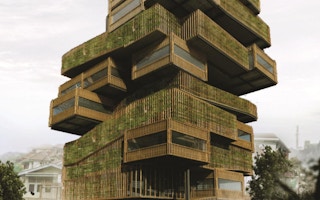Indonesia’s cities are the fastest growing in Asia, but for some of the millions that moved into the expanding metropolises from the countryside, dreams of a better life have turned sour.
Indonesia’s urban land grew by 2,100 square kilometres – three times the size of Singapore – from 2000 to 2010, according to the World Bank. However, Indonesian cities have lagged behind in infrastructure spending, with infrastructure stock growing only 3 per cent, despite average economic growth of 5.8 per cent in the mid to late 2000s.
As Indonesia’s urban population growth outpaces growth in infrastructure and job opportunities, illegal housing has sprung up on river banks, forming slums. Migrants who have been farmers their whole lives found it hard to secure jobs in the city.
Conscious of their plight, two groups of Indonesian architecture students have conceived two infrastructure designs that aim to provide urban farming work for jobless migrant workers in Bandung, the capital city of West Java.
Created over a two-week period, the student designs impressed the judges at the International Tropical Architecture Design Competition, who awarded them the top two prizes during Singapore Green Building Week at the International Green Building Conference (IGBC).
The competition was jointly organised by the Building and Construction Authority (BCA), Singapore Institute of Architects (SIA) and Singapore Green Building Council (SGBC).
Ridwan Arifin, a final year student from the Technology University of Yogyakarta, led the team that bagged the first prize. His team’s design, Vertical Farm Acupuncture (ViFA), is an eleven-storey construction in Bandung that contains facilities for hydroponic farming and water harvesting.
Speaking to Eco-Business at the sidelines of IGBC at the Sands Expo & Convention Centre on September 13, Ridwan says that Indonesia has always been an agrarian country and agriculture is an important aspect of its culture.
Ridwan hopes the ViFA can absorb and provide jobs for poor Indonesian migrants who have set up illegal housing along Cikapundung river in Bandung.
“The building is oriented for the poorest 10 per cent of the Indonesian people,” says Ridwan. “In the first phase, they can grow crops that are easy to maintain, such as cabbage, spinach and tomato. In the second phase, after the people have improved their knowledge of hydroponics agriculture, they can grow other types of crops.”
Ultimately, Ridwan hopes the ViFA can reinvigorate, instead of relocate, these poor people by having them live within a vertical farming bloc within the city. Ridwan’s group estimates that each farmer living in the ViFA can earn an average of Rp 3 million (US$226.50) from a small 36 metre squared farming site.
In addition to its steel foundations, the ViFA uses building materials from the local area, such as bamboo sourced from the village of Lembang Bandung, and minimises the use of concrete. In addition, the building incorporates unused construction materials, waste plastic and glass bottles.
Kampung on stilts
The second prize winner, the Fill-In Kampung, addresses a slightly different problem. Although there are farmers who never wanted to migrate to cities, they are still being displaced by urban expansion against their will.
In one case, a 300-hectare piece of farmland called Gedebage, located at the edge of the Indonesian city of Bandung, had been earmarked for development into a new city centre called Bandung Technopolis.
Currently, there are about 200 rice farming households in Gedebage. These farmers do not own the land they cultivate, and once urban development goes full steam ahead, they will be rendered jobless.
The designers of the Fill-In Kampung, five students from the Bandung Institute of Technology, learnt about their woes after interviewing a group of farmers in Gedebage.
“Their only skills are only those as a farmer. It’s hard for them to learn a new skill. So, we want to provide a space for them to continue farming,” says one team member, Rabita Akbari Sitompul.
Rabita’s team envisions a housing district, called the Fill-In Kampung, comprising sloping buildings covered with photovoltaic cells and urban roof farms. Surrounding these sloping buildings will be rice fields, wetlands and rain gardens.
These urban farms continue the traditional Sundanese practice of growing crops in their yard, say Rabita’s team members.
Bamboo and banana trees can be planted around the building. In addition to providing building and culinary materials, these trees also stabilise the soil by absorbing water.
The Fill-In Kampung is also capable of handling the flash floods that have caused a lot of pain for Gedebage residents. For example, the Fill-In Kampung houses are raised on stilts, continuing an architectural tradition common in many Southeast Asian villages.
“The wetland functions as a water catchment when it is flooding. As the flooding could worsen, the buildings are raised on stilts,” says Rubita.
Both the ViFA and Fill-In Kampung provide community spaces for the residents. Not only do they provide learning opportunities by providing a venue for classes, these spaces help preserve the gotong royong, the traditional village spirit.
Rabita says: “Social interaction is very important for the Sundanese people, the native people of Bandung. We design these spaces for the people to preserve their local wisdoms.”
Held annually since 2011, the International Tropical Architecture Design Competition aims to raise the awareness of the green building movement and initiatives among the younger generation and encourage them to become future architects and experts in tropical green designs.
The competition received 100 submissions from 18 countries, and five finalists were shortlisted for the final judging session. Another five Special Mention Awards were awarded.
Eco-Business is producing a special e-newsletter featuring stories on the proceedings at IGBC 2017, kindly supported by City Developments Ltd and the Building and Construction Authority. Sign up to receive the newsletter here.
















